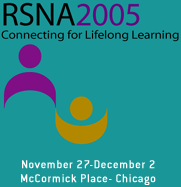
Abstract Archives of the RSNA, 2005
Xiang Liu MD, Presenter: Nothing to Disclose
Lilin Li, Abstract Co-Author: Nothing to Disclose
Per-Lennart Alwe Westesson MD, PhD, Abstract Co-Author: Nothing to Disclose
To analyze cerebral cortex compensation after ischemic stroke, by combining analysis of passive and active clenching task fMRI in 3T.
11 patients(10 males, 1 female), who recovered to Twitchell-Brunstorm stage Ⅴor Ⅵ after MCA territory ischemic stroke and 16 volunteers(9 males and 7 females) were analyzed. Active and passive clenching task fMRI(multi phase EPI, TR/TE =3000/30) was performed in GE Signa 3T. The fMRI data were analyzed by SPM99, p<0.05.
: The passive clenching fMRI result of both patient and volunteers shows not only activation in Brodmann1,2,3 area of primary sensory cortex, but also activation in Brodmann4,6 of first somatic motor area.
The hand motor ability of 6 cases were in Brunstorm gradeⅠorⅡ(group one). 6 patients were in grade Ⅲ or Ⅳ(group two). 7 patients were in grade Ⅴor Ⅵ(group three). The patient active clenching fMRI result shows more activation in the2,3 than the primary motor cortex. For patients of group one, fMRI images showed ipsilateral SMC (sensorimotor cortex) activation in the brain. In group two, 2 patients who with significant disruption of cortical spinal tract presented ipsilateral activation. The other patients in this group and the patients of group three were with bilateral SMC activation, the ipsilateral activated area was larger than the contralateral side.
Comparing with the active task result of volunteers by SPM group analysis, there are difference in bilateral Brodmann 3, 5 and 40 area of patient.
The passive clenching task could tiger motor cortex activation, which may be the mechanism about why passive rehabilitation treatment is useful for patient motor function recovery. The result that more activation in the Brodmann 2, 3, 5 and 40 area during active clenching task of patient, suggest that both sensory cortex and post-parietal cortex compensate motor function. These two area are important for the cerebral cortex plasticity after ischemic stroke.
Liu, X,
Li, L,
Westesson, P,
Cerebral Cortex Plasticity in Ischemic Stroke Patient- Evaluated by Active and Passive Clenching Task fMRI in 3T. Radiological Society of North America 2005 Scientific Assembly and Annual Meeting, November 27 - December 2, 2005 ,Chicago IL.
http://archive.rsna.org/2005/4415629.html

